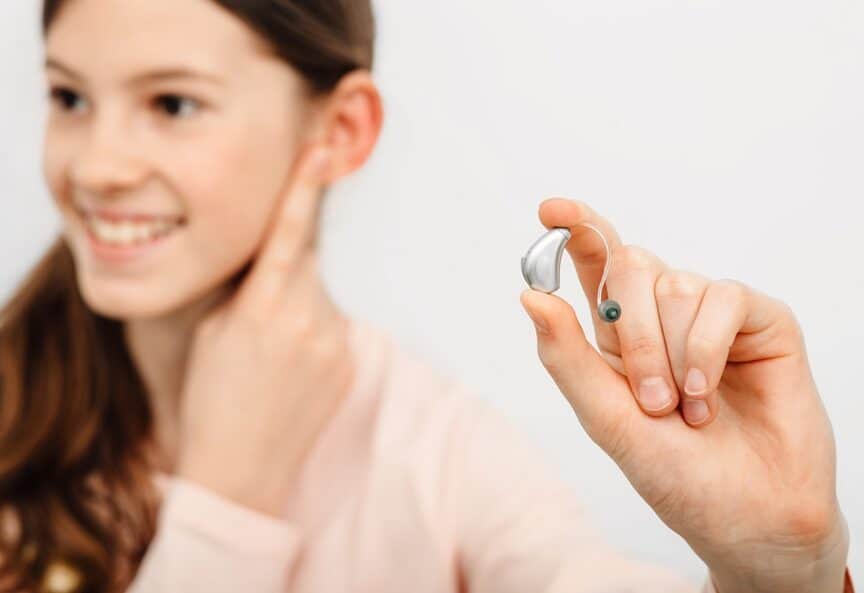- How to Care for Infants With Hearing Loss - April 15, 2024
- Hearing Aid Tips for Runners - April 5, 2024
- Overcoming Misconceptions Around Hearing Aids - March 27, 2024
You’ve been to your audiologist, taken a hearing test, and it’s been determined that you need hearing aids. Now what? While the hearing aid market may seem overwhelming, by knowing what to look for you can make the best decision for you and your lifestyle.
How do digital hearing aids work?
When you took your hearing test, or audiogram, a graph was printed that shows you hearing in terms of both frequencies and volume in decibels. Using this information, digital hearing aids will be able to amplify the exact frequencies needs without changing the sounds you already hear normally.
The amplification process works through a microphone and receiver process. The microphone picks up the sound which is then amplified as needed and transmitted through the receiver into the wearer’s ears. Where the microphone and receiver sit in the ear can change based on the type of hearing aid.
This process is different with analog hearing aids. Where digital hearing aids only amplify the exact sounds needed, analog hearing aids amplify all sound as one, similar to turning the volume up on a television.
What are the types of hearing aids?
There are a few main categories of hearing aids: behind the ear (BTE), in the ear (ITE), and in the canal (ITC) hearing aids. All of these types can be broken down into more specific styles but to get a better understanding of how they work we will look at these more broadly.
Behind the ear (BTE)
BTE hearing aids have the bulk of the technology in the device resting on the back of the ear. The microphone and amplification system is directed to the receiver through either an ear mold or a small dome like structure that sits in the ear. Receiver in the ear (RIE) is a type of BTE hearing aid that is typically smaller in size and does not use an ear mold in the ear.
In the ear (ITE)
ITE hearing aids, as the name implies, have the entire device siting in the ear. These can be harder to keep clean than BTE hearing aids because the sensitive pieces of technology are exposed to more ear wax.
In the canal (ITC)
ITC hearing aids are similar to ITE hearing aids in that they sit entirely in the ear, however they are even smaller and therefore sit deeper in the ear canal. ITC hearing aids can be difficult handling for older adults due to their small size and like ITE hearing aids can be more challenging to keep clean and maintain.
ITC hearing aids can be further broken down by size. Completely in the canal, or CIC, hearing aids are even smaller and are good for adults who prefer less visible options.
What are the advantages to digital hearing aids?
Aside from the sound specifications that digital hearing aids allow compared to analog hearing aids, there are many features that can be used as well.
- Noise reduction– With the amplification of all sound in analog hearing aids a user will pick up noises that they don’t necessarily want amplified such as the air conditioner or background noise in a crowded restaurants. Digital hearing aids have noise reduction options that manage some of that background noise to help the user hear conversations better.
- Directional microphones– These are used in digital hearing aids to hear whatever the user is facing. For example, in a restaurant, the devices will focus in on the person you are facing and speaking to while simultaneously reducing background noise.
- Bluetooth- With Bluetooth capabilities now available in some digital hearing aids, users can connect to other Bluetooth compatible devices such as phones, music, and televisions.
- T-coils– Tele-coils, or T-coils, are small wires in the hearing aid that can connect to public induction loops that are present in places such as theaters, churches, and other public spaces that use t-coils. This allows the transmission to go directly to the hearing aids.
- Remotes– Hearing aids now have remote control options that allow the user to change settings or volumes on their own without going back to the audiologist. These can come in the form of an actual handheld remote or they can be an app on your smart phone.
There are many options available for hearing aids users today, speak with your hearing health provider to determine which is right for you.

